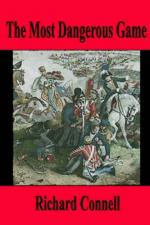|
This section contains 377 words (approx. 2 pages at 300 words per page) |
The Most Dangerous Game
Characterization is an important device used in this story, as it provides insight into the way characters are presented. For example, General Zaroff's physical appearance: "He was a tall man past middle age, for his hair was a vivid white, but his thick eyebrows and pointed military mustache were as black as the night from which Rainsford had come. His eyes too, were black and very bright. He had high cheek bones, a sharp cut nose, a spare, dark face, the face of a man used to giving orders the face of an aristocrat." He was a sophisticated man, yet he was manipulative, arrogant, and cold hearted. When his servant Ivan died, he was aggravated that he would have to replace him. "Two slight annoyances kept him from perfect enjoyment. One was the thought that it would be hard to replace Ivan."
Role-reversal is another literary device used in this story. For example, in the beginning of the story, before Rainsford arrived on the island, he was a hunter. After arriving on the island, and meeting General Zaroff his role were reversed from the hunter to the hunted. However, towards the end of the story the roles were reversed again, Rainsford became the hunter and Zaroff was the hunted.
The conflict in this story is shown in many different forms. The internal conflict is man vs. self. When Rainsford was being hunted in the jungle he had to use all his physical and mental abilities to try and outsmart General Zaroff. The external conflicts are man vs. man, hunter vs. hunter, and predator vs. prey. Though there are many conflicts in this story, the main one is man vs. man.
With the use of these and other literary devices, Richard Connell created the story for which he is best known, The Most Dangerous Game.
Arp, Thomas R., and Greg Johnson. Perrine's Literature: Structure, Sound, and Sense 8th Edition. New York: Harcourt Brace, 2002.
|
This section contains 377 words (approx. 2 pages at 300 words per page) |


